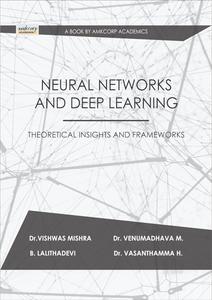
Free Download NEURAL NETWORKS AND DEEP LEARNING: THEORITICAL INSIGHTS AND FRAMEWORKS
by Dr. VISHWAS MISHRA, Dr. VENUMADHAVA M., B. LALITHADEVI
English | March 18, 2024 | ASIN: B0CW1H192Z | 253 pages | PNG (.rar) | 39 Mb
"NEURAL NETWORKS AND DEEP LEARNING: THEORITICAL INSIGHTS AND FRAMEWORKS" is a comprehensive guide that dives deep into the world of neural networks and their applications in modern technology. From foundational theories to cutting-edge advancements, this book provides readers with a comprehensive understanding of deep learning and its potential impact on various fields.
In Chapter 1: Introduction to Neural Networks and Deep Learning, readers are introduced to the theoretical underpinnings of deep learning and its real-world applications. The chapter explores key concepts, navigates through neural network architectures, and discusses the current landscape of deep learning research. It also addresses ethical considerations and social implications, highlighting the intersection of deep learning with other disciplines.
Chapter 2: Mathematical Foundations of Neural Networks lays the groundwork by covering essential mathematical concepts relevant to deep learning. From linear algebra to calculus, probability, and statistics, readers gain insights into the mathematical rigor behind neural network operations. The chapter also delves into optimization techniques and advanced mathematical concepts crucial for understanding deep learning models.
Chapter 3: Single-Layer Perceptrons and Feedforward Networks explores the building blocks of neural networks, including perceptrons and activation functions. It discusses universal approximation theorems, backpropagation algorithms, and weight initialization techniques. Additionally, the chapter addresses challenges such as vanishing and exploding gradient problems, along with evolutionary algorithms and self-organizing maps.
Chapter 4: Convolutional Neural Networks (CNNs) focuses on specialized architectures designed for image processing tasks. Readers learn about convolutional layers, pooling operations, and hierarchical feature learning. The chapter also covers object localization, transfer learning, and interpretability of CNNs, along with advanced architectures like capsule networks.
Chapter 5: Recurrent Neural Networks (RNNs) delves into sequential data processing, temporal dependencies, and architectures like Long Short-Term Memory (LSTM) networks and Gated Recurrent Unit (GRU) networks. It addresses training challenges and explores real-world applications of recurrent networks.
Chapter 6: Generative Adversarial Networks (GANs) introduces readers to the innovative concept of GANs and their applications in image generation. The chapter discusses training dynamics, challenges, and ethical considerations surrounding GANs. It also explores future developments and applications in creativity and adversarial robustness.
Chapter 7: Autoencoders and Variational Autoencoders (VAEs) explores unsupervised learning techniques for representation learning and anomaly detection. Readers learn about various types of autoencoders, including adversarial autoencoders and quantum autoencoders.
Chapter 8: Reinforcement Learning and Deep Q Networks (DQNs) provides insights into reinforcement learning fundamentals, Markov decision processes, and deep Q networks. It discusses policy gradient methods and their applications in real-world scenarios.
Chapter 9: Transfer Learning in Deep Neural Networks explores transfer learning paradigms, domain adaptation techniques, and the role of transfer learning in achieving explainable AI. Readers gain insights into evaluating performance and generalization in transfer learning, along with applications in various domains.
"NEURAL NETWORKS AND DEEP LEARNING: THEORITICAL INSIGHTS AND FRAMEWORKS" is an invaluable resource for researchers, practitioners, and enthusiasts looking to deepen their understanding of neural networks and harness the power of deep learning in diverse applications.
